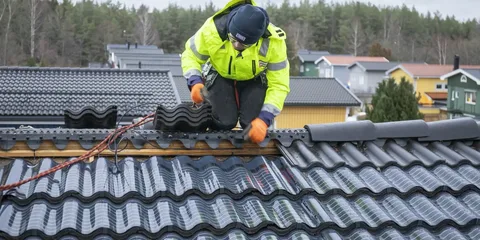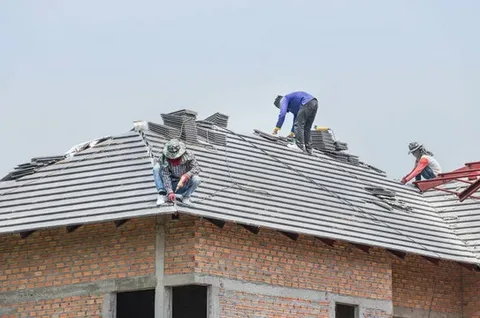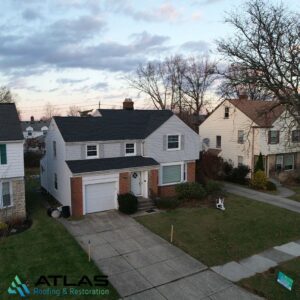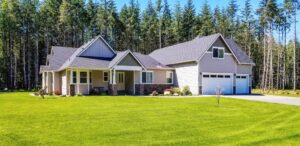Commercial roofs are an essential part of any building. Not only do they protect the structure from the elements, but they also contribute to energy efficiency, comfort, and overall building integrity. Over time, however, commercial roofs can encounter various problems that may compromise their functionality. Identifying these issues early and addressing them promptly can help extend the roof’s lifespan, reduce repair costs, and ensure a safe and comfortable environment for building occupants.
In this blog, we will explore some of the most common commercial roof problems and discuss how to address them effectively.
1. Leaks
One of the most frequent and problematic issues with commercial roofs is leaks. Leaks can occur for a variety of reasons, including damaged flashing, worn-out roofing materials, clogged drains, or improper installation. A leak, if not addressed quickly, can lead to water damage, mold growth, structural damage, and costly repairs.
How to Address Leaks:
- Inspection: Regular roof inspections are crucial to detect potential leaks early. Inspect the roof for signs of water damage, such as damp spots, stains, or mold growth.
- Seal Cracks and Gaps: Any visible cracks or gaps in the roofing material should be sealed with a high-quality roofing sealant.
- Repair Flashing: Flashing is used to seal areas where the roof meets walls, chimneys, or other protrusions. Over time, flashing can wear out or become damaged. Repair or replace any damaged flashing to prevent leaks.
- Clogged Drains: Ensure that all roof drains, gutters, and downspouts are clear of debris. Clogged drains can lead to standing water, which can eventually cause leaks.
2. Pooling Water
Pooling water occurs when water accumulates on the roof’s surface instead of draining properly. This problem is often seen in flat or low-slope roofs, where the design doesn’t allow for sufficient drainage. Over time, standing water can break down roofing materials, causing them to deteriorate and increase the risk of leaks.
How to Address Pooling Water:
- Regrade the Roof: If the roof’s slope is inadequate, it may need to be regraded to allow for proper water drainage.
- Install Additional Drains: Installing additional drains, scuppers, or gutters can help prevent water from pooling in low-lying areas.
- Apply a Roof Coating: A reflective roof coating can help direct water to the drains and improve drainage efficiency. These coatings also provide additional protection from UV rays, reducing the risk of material breakdown.
- Regular Maintenance: Ensure that the roof is regularly inspected and maintained to prevent any new areas of pooling water.
3. Punctures and Tears
Punctures and tears are another common issue with commercial roofs, especially those made from single-ply membranes like TPO, EPDM, or PVC. These roofs are prone to damage from foot traffic, debris, hail, and even falling tree branches. Punctures and tears in the roofing material can lead to leaks and other water-related issues.
How to Address Punctures and Tears:
- Inspect for Damage: Regularly check for punctures and tears, especially after severe weather events. Even small punctures can lead to significant problems if left unattended.
- Repair or Patch: Small punctures can often be patched with roofing materials designed for the specific roof type. For larger tears, you may need to replace the damaged section of the roof.
- Protect the Roof: To prevent further damage, minimize foot traffic on the roof and remove any debris promptly. If tree branches are nearby, trim them to prevent falling debris from causing punctures.

4. Poor Roof Installation
A poorly installed roof can cause a range of problems, from leaks to poor energy efficiency. Improper installation may include issues such as inadequate sealing of seams, insufficient insulation, or using substandard materials. These problems can often go unnoticed until they cause significant damage.
How to Address Poor Roof Installation:
- Hire Qualified Contractors: Always hire an experienced and reputable roofing contractor to install or replace your commercial roof. Poor installation can lead to costly repairs and premature roof failure.
- Insist on Quality Materials: Ensure that only high-quality roofing materials are used for your roof. Cheaper, lower-quality materials may save money initially but often lead to higher repair costs in the future.
- Regular Inspections: Even if your roof was installed properly, regular inspections are still necessary to ensure that the installation remains intact and functional over time.
5. Damaged Flashing
Flashing is a material used around roof penetrations such as chimneys, vents, skylights, and HVAC units. Flashing helps prevent water from seeping into the roof at these vulnerable points. Over time, flashing can become cracked, bent, or otherwise damaged due to weather conditions, age, or improper installation.
How to Address Damaged Flashing:
- Inspect Flashing Regularly: Inspect flashing during routine roof inspections, particularly around penetrations and edges where leaks are most likely to occur.
- Replace Damaged Flashing: If flashing is damaged or missing, replace it with new flashing made from durable materials like aluminum or stainless steel.
- Re-seal Flashing: Ensure that the flashing is properly sealed with a high-quality roofing sealant to prevent water from infiltrating the roof.
6. Roof Membrane Shrinkage
As roof membranes age, they can shrink due to exposure to UV rays and extreme weather conditions. Shrinkage can lead to the separation of seams, cracks, and other forms of damage that compromise the roof’s waterproofing capabilities.
How to Address Roof Membrane Shrinkage:
- Monitor for Shrinkage: Regularly check for signs of membrane shrinkage, such as gaps or wrinkles along seams and edges.
- Replace or Repair Membrane: In some cases, the roof membrane may need to be replaced entirely. However, if the damage is minimal, localized repairs may be sufficient.
- Install UV Protection: Consider applying a UV-resistant coating to help protect the membrane from premature aging and shrinkage.
7. Moss and Algae Growth
Moss and algae can thrive on commercial roofs, particularly in damp or shaded areas. Over time, moss and algae can break down roofing materials, causing them to deteriorate and shorten the roof’s lifespan.
How to Address Moss and Algae Growth:
- Regular Cleaning: Clean the roof regularly to remove moss, algae, and debris. Use a soft brush or low-pressure washer to avoid damaging the roofing material.
- Apply Algae-Resistant Coating: Consider applying an algae-resistant roof coating that can help prevent future growth.
- Trim Overhanging Trees: Overhanging branches can provide the shade that encourages moss and algae growth. Trim any trees that shade the roof to minimize these conditions.

8. Wear and Tear from UV Rays
UV rays from the sun can cause roofing materials to break down over time. This is especially true for flat roofs and older roof materials. UV damage can lead to material degradation, cracking, and eventually, roof failure.
How to Address UV Damage:
- Apply Reflective Coatings: A reflective roof coating can reduce the amount of UV radiation absorbed by the roof, helping to preserve the integrity of the roofing materials.
- Install UV-Resistant Materials: Consider using UV-resistant roofing materials for new installations or replacements to reduce the impact of sun exposure.
- Regular Inspections: Regularly inspect the roof for signs of UV damage, such as fading or cracking. Early detection can help prevent larger issues.
Conclusion
Maintaining a commercial roof requires ongoing care and attention to prevent common issues from escalating into costly repairs. By regularly inspecting your roof, addressing problems promptly, and investing in high-quality materials and services, you can significantly extend the lifespan of your commercial roof and ensure its performance for years to come.
If you’re facing roof problems or need assistance with regular maintenance, Atlas Roofing & Restoration is here to help. Our experienced team provides reliable roofing solutions and restoration services across Northeast Ohio. Reach out to us for a consultation and take the first step toward protecting your commercial property.




